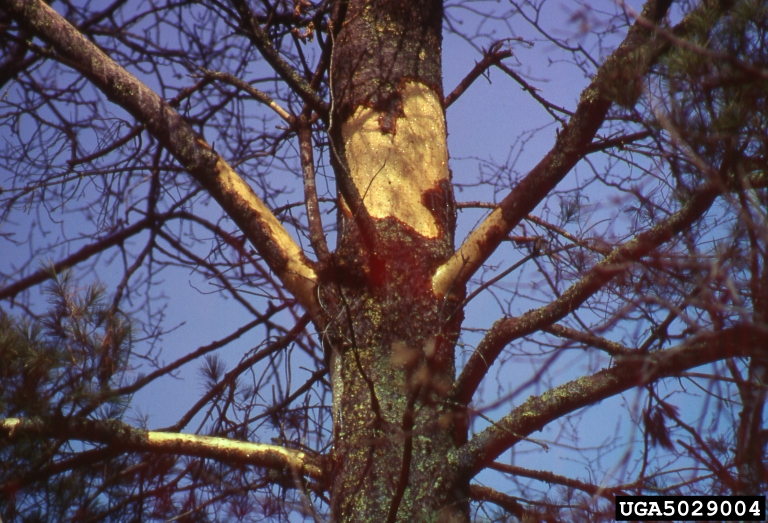 Porcupines in Arizona - October 21, 2015 Jeff Schalau, Agent, Agriculture & Natural Resources University of Arizona Cooperative Extension, Yavapai County Porcupines are not common in the Verde Valley, but they are here. Some dog owners can probably attest to this. Porcupines often prefer to live in coniferous forests, but sometimes wander to lower elevation riparian areas and wooded uplands. They eat herbaceous plants (including corn, alfalfa, and other crops), inner tree bark, twigs, leaves, and show a preference for Ponderosa pine, aspen, cottonwood, and willow. Trees with thin, smooth bark are preferred over those with rough, thick bark. Porcupines are active year-round and are primarily nocturnal. They usually rest in a tree during the day. They also use caves, rockslides, thick timber, or slash piles for protective shelter. It is interesting to note that their feeding habits indirectly benefit other wildlife species. Clipped twigs that fall to the ground are used by deer and other mammals during winter months. In addition, the damage they do to trees exposes the sapwood. This allows insects, fungi, and birds to feed on the decaying wood. Other wildlife species then use these tree cavities for shelter and reproduction. Porcupines are the second largest rodent in North America. They breed in fall, and after a seven month gestation period, usually produce one offspring in spring. The young are capable of eating plant material within a week of birth and they generally stay with the female parent through the first summer. Survival rates of young porcupines are usually high. Porcupines have long claws and the soles of their feet have a pebbly surface. This helps them climb trees and provides them with a keenly developed sense of touch. Contrary to popular belief, they do not “shoot” their quills. Rather the quills are loosely attached and easily dislodged when the flailing tail makes contact with an enemy. Tiny barbs on the quill tip expand when moistened by the enemy’s tissue fluid and are pulled inward by muscle contractions. Each animal has about 30,000 quills. The tail quills also help them to grip tree trunks and branches. Predators do a fairly good job keeping porcupine populations in check. Some porcupine predators in our area include coyotes, bobcats, mountain lions, black bears, and great horned owls. The literature mentions that coyotes are noted for eating the quills. How they maneuver these through their digestive tracts is not known, but they have been noted in scat. In agricultural and residential areas, porcupines cause a variety of unwanted damage. Fruit and ornamental trees, sweet corn, alfalfa, and small grains are often consumed. They have also been known to chew on wooden tool handles and canoe paddles in search of salt and buildings in search of plywood resins. Sometimes they also show a preference for pressure-treated lumber. The best strategy to prevent damage from porcupines is exclusion. Fences, climbing barriers, and cages around plants are commonly used. For gardens, 18 inch tall poultry wire with a smooth electric wire 1.5 inches above the top is effective. Also, a simple smooth electric wire 4-6 inches above ground can provide adequate protection. This also can prevent beaver damage. These low wires must be maintained by trimming low growing vegetation so that it does not become grounded and ineffective. Of course, porcupines are not the only pests to exclude from your garden. Javelina, wood rats, rabbits, gophers, deer, elk, etc. must also be considered. The Arizona Game and Fish Department considers porcupines a “furbearer species” but there is currently no season to hunt them. Individual trees can be protected by wrapping the trunk with 30" wide aluminum flashing (this makes it difficult to climb) or creating a sheet metal barrier that they cannot climb around that is fixed to the trunk. Live trapping is another solution to manage persistent porcupines. These can be baited with salt soaked cloth, sponge, or piece of wood. In most cases, I would recommend calling a licensed wildlife damage control operator to handle this for you. Follow the Backyard Gardener on Twitter – use the link on the BYG website. If you have other gardening questions, call the Master Gardener help line in the Camp Verde office at 928-554-8992 or e-mail us at verdevalleymg@gmail.com and be sure to include your name, address and phone number. Find past Backyard Gardener columns or provide feedback at the Backyard Gardener web site: http://cals.arizona.edu/yavapai/anr/hort/byg/. Additional Resources Walter P. Taylor and Arizona's Porcupines David E. Brown and Randall D. Babb www.gf.state.az.us/i_e/pubs/ArizonaPorcupines.shtml Porcupine Ecology and Damage Management Techniques for Rural Homeowners University of Wyoming Cooperative Extension Service www.wyomingextension.org/agpubs/pubs/B1073.pdf 

|